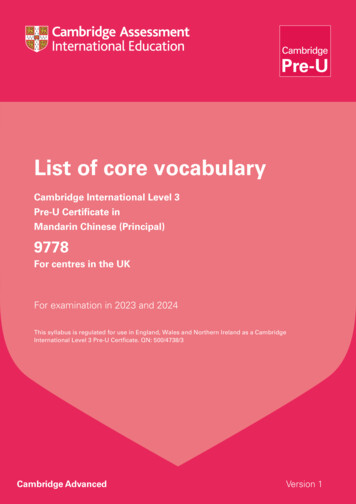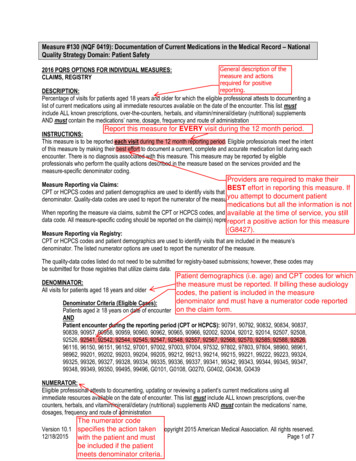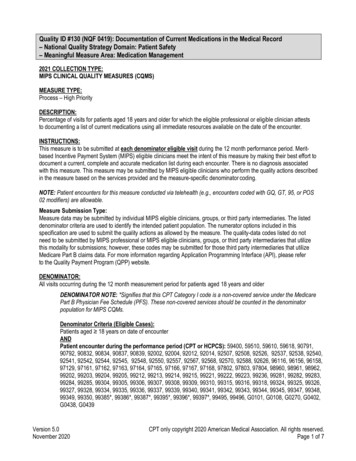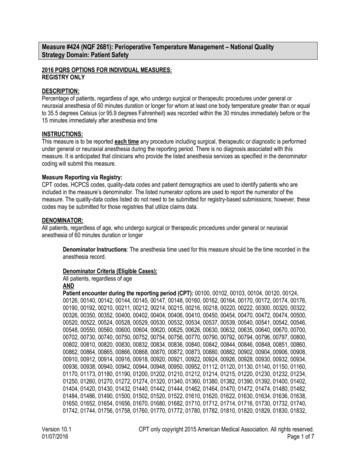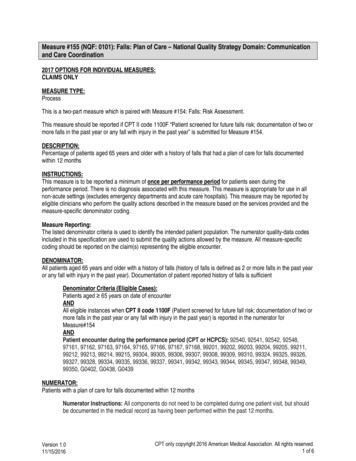
Transcription
Do You Measure Up:Hardwiring SepsisProcesses to Meet CoreMeasuresKathleen M. Vollman RN, MSN, CCNS, FCCM, FAANClinical Nurse Specialist/Educator/ConsultantADVANCING NURSING LLCkvollman@comcast.netNorthville, Michiganwww.vollman.com ADVANCING NURSING LLC 2016
Overview Discuss the four tier process for programdevelopment: I-Organizational Commitment IIScreening III-Sepsis Bundles Implementation IVMeasurement Understand the milestones to achieve in each of theTiers Identify common barriers to program implementationand discuss strategies to overcome common barrier Design a measurement process to evaluate programand the SEP-1 measures
Severe Sepsis:A Significant Healthcare Challenge Major cause of morbidity and mortality worldwide– Leading cause of death in noncoronary ICU (US)1– 10th leading cause of death overall (US)2* More than 750,000 cases of severe sepsisin the US annually3 Sepsis occurs in just 10% of U.S. hospital patients, butit contributes to as many as half of all hospital deaths Most expensive condition treated in hospitals in 2013,23.7 billion or 6.2% aggregate cost4 In the US, more than 500 patients die of severe sepsisdaily3†* Based on data for septicemia† Reflects hospital-wide cases of severe sepsis as defined by infection in the presence of organ dysfunction1. Sands KE, Bates DW, Lanken PN, et al. Epidemiology of sepsis syndrome in 8 academic medical centers. JAMA 1997;278:234-40.2. National Vital Statistics Reports. 2005.3. Angus DC, Linde-Zwirble WT, Lidicker J, et al. Epidemiology of severe sepsis in the United States: analysis of incidence,outcome and associated costs of care. Crit Care Med 2001;29:1303-10.4. AHRQ: accessed 06/27/2016 agency-healthcare-research-and
Sepsis is #1 Cause of Inpatient Deaths
Sepsis Impact on Mortality in Hospitals1 out of 2-3 Deaths r/t Sepsis, Most POAIn KPNC 2012 subset, patient meeting criteria for EGDT comprised 32.6 percentof sepsis deaths & patients with sepsis, normal BP & lactate 4 comprised55.9% of sepsis deathsLiu V, et al. JAMA,2014:May 18th, online.
Sepsis Practice Collaborative Model4 Tier Process for Program ImplementationMeasuringSuccessCQI1Implementation ofthe Sepsis BundlesEarly Screening with Tools and TriggersOrganizational Consensus that Severe SepsisMust be Managed Early and AggressivelyHand WashingVAE (VAP) Bundle CAUTIBSIInfection PreventionAdapted from: Sepsis Solutions InternationalDocumentation Improvement Accurate Coding1ContinuousQuality Improvement
Tier I: Organizational Consensus and SupportMilestones and Checklist1. Define Sepsis Program Goal and aligned withorganizational goals2. Identify Executive sponsor3. Collect Baseline Data—essential step4. Develop sepsis team(do we have all the right peoplehere?) and schedule monthly(minimum) meeting for atleast 6 months5. Identify nursing and physician champions in ED and ICUand ensure champions attend team meeting–Create a sepsis coordinator position to oversee program6. Begin to define action plan and timeline for programdevelopment and implementation
Building a Severe Sepsis Tool Kit:Project Team CharterProblem Statement:Severe Sepsis is Common and DeadlyTeam MembersGoalsED, ICU, Patient Care UnitRepresentatives, Administration,Medical Staff, Nursing,Pharmacy, Performance Improvement,Case Management, LaboratoryReduce severe sepsis mortality (makethe goal specific and measurable)Business CaseScopeIn comparison to other ICU patients,severe sepsis patients have a highermortality rate, increased LOS, and anincreased need for a ventilatorSevere sepsis patients in the ED, ICU,and patient care unitsBenefitsMilestonesPotential to improve outcomesImplementation of Tiers 1, 2, 3, and 4
Tier I: Organizational Consensus and SupportMilestones and Checklist1. Define Sepsis Program Goal and aligned withorganizational goals2. Identify Executive sponsor3. Collect Baseline Data—essential step; understandyour current process4. Develop sepsis team(do we have all the right peoplehere?) and schedule monthly(minimum) meeting for atleast 6 months5. Identify nursing and physician champions in ED and ICUand ensure champions attend team meeting6. Begin to define action plan and timeline for programdevelopment and implementation
Baseline Data Collection Process Pick time period for medical record query Sample size: minimum of 20 pts per ICU Query strategies:– ICD 9 codes: 785.52 and 995.92 or DRG 870, 871, 872--now also look at ICD-10 R65.20 and R65.21– Patients in ICU on 1-2 antibiotics, vasopressor (reviewcharts to see if meet criteria for severe sepsis with lactate 4 or septic shock before including in outcome data orprocess data) Select Data Collection Elements– Outcome– Process
Sepsis Patient Flow Template: AmbulanceICUHighlight thesteps with thebiggest issuesAmbulanceCustomerRequirements:Supplier Inputs:ERAssessTriageD/TQuery Pt.PerformAssessmentD/T% pt. screened:Total L/T toadmit:ResuscitateDiagnoseERD/TD/TTotal L/T todiagnosis:1. List the process steps beloweach box2. For each process step include job title ofpersons performing the step3. For each queue quantify the delay time (D/T)4. Then total each to get L/T for the overallprocess% bundle use:Labs:Meds:IV’s:Monitoring:CVP:MAP:ScvO2:If bundle is not used,describe theseresuscitation components
Sepsis Patient Flow Template: ICUER/FloorSupplier Inputs:Total L/T irements:ICUAssessAdmit toICUICUD/TCustomerHighlight thesteps with thebiggest issuesResuscitateD/T% bundle use:Labs:Meds:IV’s:Monitoring:CVP:MAP:1. List the process steps belowScvO2:each box2. For each process step include job title ofpersons performing the step3. For each queue quantify the delay time (D/T)4. Then total each to get L/T for the overallprocessManageD/TIf bundle is not used,describe theseresuscitation components
Tier I: Organizational Consensus and SupportMilestones and Checklist1. Define Sepsis Program Goal and aligned withorganizational goals2. Identify Executive sponsor3. Collect Baseline Data—essential step4. Develop sepsis team(do we have all the right peoplehere?) and schedule monthly(minimum) meeting for atleast 6 months5. Identify nursing and physician champions in ED andICU and ensure champions attend team meeting–Create a sepsis coordinator position to oversee program6. Begin to define action plan and timeline for programdevelopment and implementation
The Team Is KEY!Can Be Major Barrier If Not Functioning Well Must have nurse and physician champions from EDand ICU (need at least one physician at all meetings) Must be linked in the organization’s quality oroperational structure— Are you linked? Must meet at least 1-2 times per month Team members must be well educated on the evidenceand armed with tools and knowledge to change behaviorat the bedside— Does the team need moreeducation? MUST have bedside nurses on team—provide realitycheck and best knowledge of barriers— Do you?Consider developing nurse champions on each patient care unit and shift
Sepsis Practice Collaborative Model4 Tier Process for Program ImplementationMeasuringSuccessCQI1Implementation ofthe Sepsis BundlesEarly Screening with Tools andTriggersOrganizational Consensus that Severe SepsisMust be Managed Early and AggressivelyHand WashingVAE (VAP) Bundle CAUTIBSIInfection PreventionAdapted from: Sepsis Solutions InternationalDocumentation Improvement Accurate Coding1ContinuousQuality Improvement
Surviving Sepsis CampaignGuidelines: 2012 Consensus committee of 68 international experts presenting 30international organizations Used GRADE system to guide assessment of quality ofevidence from high (A) to very low (D) and to determine thestrength of recommendations as strong (1) or weak (2) Some recommendations were ungraded (UG) Guidelines included recommendations in 3 areas:1. Directly targeting severe sepsis2. Targeting general care of critically ill patient, considered highpriority in severe sepsis3. Pediatric considerationsDellinger RP, et al. Crit Care Med. 2013;41580-637
Old Definitions Sepsis is defined as the presence (probable ordocumented) of infection together with systemicmanifestations of infection. Severe sepsis is defined as sepsis plus sepsisinduced organ dysfunction or tissue hypoperfusion;at least two SIRS criteria to be present in thesetting of known or suspected infection Septic shock is a state of acute circulatory failure;severe sepsis plus hypotension not reversed withfluid resuscitation)
New Definitions Sepsis is defined as life-threatening organdysfunction caused by a dysregulated hostresponse to infection. Septic shock is defined as a subset of sepsis inwhich underlying circulatory and cellularmetabolism abnormalities are profound enough tosubstantially increase mortality.
Sepsis 3:Singer et al, JAMA 2016. PMID: 26903338 Sepsis is: ‘life-threatening organ dysfunction caused by adysregulated host response to infection’ Sepsis-3 does away with:– SIRS criteria (sepsis is pro- and anti-inflammatory)– Severe sepsis (sepsis the old severe sepsis)– Antiquated concepts: sepsis syndrome; septicemia Sepsis-3 codifies the quantification of organ dysfunctionthrough the SOFA score (Sequential Organ FailureAssessment) Septic shock: vasopressor-dependent hypotension lactate 2 Sepsis-3 includes clinical criteria to predict lifethreatening disease
Sepsis-3 WorkflowSinger et al, JAMA 2016. PMID: 26903338Simpson SQ, et al. Chest, 2016; doi:10.1016/j.chest.2016.02.653
So, What Now There is no consensus among other professional organizations includingACEP and ACCP (CMS usually does not like to make changes unlessall professional societies in agreement) CMS is reviewing these changes to determine what changes (if any) tomake to the Sepsis measure The earliest changes can be incorporated would be for January 1, 2017discharges – and even this date is highly unlikelyKeep Following Current CMSDefinitions/Measurements
SSC GuidelinesScreening We recommend routine screening of potentiallyinfected seriously ill patients for severe sepsis toincrease the early identification of sepsis and allowimplementation of early sepsis therapy (1C) Performance improvement efforts in severe sepsisshould be used to improve patient outcomes (UG)Dellinger RP, et al. Crit Care Med. 2013;41580-637
Finding the PatientsRedefining what a ‘septic shock’ patient looks likeBeforeSupine in bedVentilatorFluids wide openIncreasing vasopressorsMinimally responsiveNOWSitting up in bedNasal cannulaIV bolusesWeaning vasopressorsAwake“Don’t look sick enough to be in ICU or to have a central line”Must correct this misperception
Severe Sepsis: Defining a Disease ContinuumInfectionSIRSAdult CriteriaA clinical response arising from anonspecific insult, including 2of the following:Temperature: 38 C or 36 CHeart Rate: 90 beats/minRespiration: 20/minWBC count: 12,000/mm3,or 4,000/mm3,or 10% immatureneutrophilsSIRS Systemic Inflammatory Response SyndromeBone et al. Chest.1992;101:1644-1654.SepsisSIRSwith apresumed orconfirmedinfectiousprocessSevere SepsisSepsiswith 1 sign of organdysfunction, hypoperfusionor hypotension.Examples: Cardiovascular(refractory hypotension) Renal Respiratory HepaticShock Hematologic CNS Unexplained metabolic acidosis
Tier II: Screening for Severe SepsisMilestones and Checklist Develop screening process for ED, rapid responseteam, ICU and eventually housewide Develop audit process to evaluate compliance andeffectiveness Ensure screening process has clear “next steps”defined for nursing staff
Why Do You Need to Have a ScreeningProcess? TIME IS TISSUE!!– Similar to trauma, AMI, or stroke, the speed andappropriateness of therapy administered in the initial hoursafter severe sepsis develops are likely to influenceoutcomes.1 To screen effectively, it must be part of the nurses’ dailyroutines— i.e., part of admission and shift assessment Must define a process for what to do with the results ofthe screenIf you don’t screen you will miss patientsthat may have benefited from the interventions1. Dellinger RP, Levy MM, Carlet JM, et al. Surviving Sepsis Campaign: International guidelines for management of severe sepsisand septic shock: 2008. Crit Care Med. 2008;36:296-327.
Paper or Electronic .That is the QuestionMethodProsLimitationsPaper form Nurses critically think as they screen thepatientEasy and quick to developNo cost Screening is intermittentPaper can be misplacedStatic—no ability to automate analert Nurses critically thinks as they screen thepatientCan automate alerts for positive screens Screening is intermittentLength of programming timeCost 24 hour screeningCan automate alerts for positive screens Nurse does not screen patient—potential loss of screeningknowledge and critical thinkingComputer not reliably able toidentify patients who have infectionComputer not able to discern ifSIRS is valid or organ dysfunctionis new EMR formEMR—real time,continual screening EMR—real timeand scheduled Form fires and pre populates for nurse toscreen upon admission and each shift—nurse critically thinks24 hour screeningManual screen completed when EMRalert fires---nurse discerns/validatesappropriateness/correctness of alert Screening form needs to bedeveloped in EMR—programingtime and costs
PATIENTCAREUNIT SEVERESEPSISSCREENINGTOOL
Screening Tool Examples
Make Screening for Severe SepsisProcess-Dependent Weave into fabric of current practice Bedside nurse should do the screening—every shift andprn with condition changes Define expectation to screen during shift assessmentand PRN with changes in patient’s conditions Screen for severe sepsis with every rapid response ormedical response team call Identify strategies for initiation of therapyonce patient with positive screen for severe sepsis isidentified
Strategies: Establish Trigger for RapidImplementation of SSC Bundles Clearly define nextsteps for patientswith positive screenfor severe sepsis– Alert RRT/Med Team– Notify Physician– Begin 3 hour bundle:lactate, bloodcultures, antibiotics,fluidSBARSituation:Screened Positive for Severe SepsisBackground:1. Positive Systemic Response to Infection2. Known or suspected infection3. Organ dysfunction: share which organsAssessment:Share any other clinical changes?Recommendations:1. I need you to come and evaluate the patient toconfirm if they have severe sepsis2. It is recommended that I get an ABG, lactate,blood cultures and a CBC (if 12 hrs since last one).Can I proceed and get these?3. Any other labs you would like me to obtain?you want to order antibiotics?Do4. If patient is hypotensive: Can I start an IV andgive a bolus of NS—30ml/kgDate/time of call:RRT called: Yes No
Audit Screening Process
What Do We Want to Learn? Screening compliance all of the patients arebeing screened for severe sepsis Screens are valid Are the screens being donecorrectly Screens are reliable Screens are consistentfrom RN to RNIf patient screens positive for severe sepsis, were theappropriate interventions completed
Screening: Barriers/Strategies Barriers– Time for nurses to do it (perception vs. reality)– Screening is not specific only for severe sepsis– Positive screen is not a diagnosis of severe sepsis Strategies– Must assign responsibility and enforce accountability– Perform audits to measure complianceand identify problems– Round on unit and ask nurses how it is goingand discuss issues
Sepsis Practice Collaborative Model4 Tier Process for Program ImplementationMeasuringSuccessCQI1Implementation ofthe Sepsis BundlesEarly Screening with Tools and TriggersOrganizational Consensus that Severe SepsisMust be Managed Early and AggressivelyHand WashingVAE (VAP) Bundle CAUTIBSIInfection PreventionAdapted from: Sepsis Solutions InternationalDocumentation Improvement Accurate Coding1ContinuousQuality Improvement
Early Goal Directed TherapyMethodology: 263 severe sepsis patients Early Goal-DirectedTherapy (EGDT) Continuous ScvO2monitoring & tx with fluids,blood, inotropes &/orvasoactives to maintain: ScvO2 70%, SaO2 93%, Hct 30%, CI/VO2 CVP 8-12 MAP 65 UO .5ml/kg/hr Standard Therapy CVP 8-12 MAP 65 UO .5ml/kg/hrRivers et. al. N Engl J Med. 2001;345;19:1368-1377.
Early Goal-Directed Therapy Results28-day Mortality60504049.2%NNT 7-8P 0.01*33.3%3020100Standard TherapyEGDTn 133n 130*Key difference was in sudden CV collapse, not MODSRivers et. al. N Engl J Med. 2001;345;19:1368-1377.
The Changing Paradigm of SepticShock Management ProCESS trial-randomized, 31 centers, 1341patients ARISE trial- randomized, 51 centers(mostlyAustralia and New Zealand), 1600 patients Promise—randomized, UK, 56 centers, 1260patients
Results of 3 International Studies2014-2015 ARISE and Promise had two groups: EGDT and Usual care ProCess had three groups: EGDT, structured resuscitationand usual care Before randomization all patients received antibiotics and anaverage of 2500ml of NS (equal to 30ml/kg), had bloodcultures and lactate drawn No statistically significant difference in mortality betweengroups Mortality rate 18% for ARISE & ProCess Mortality rate 30% for PromiseProCESS Investigators, 2014; 370:1683-1693ARISE Investigators et al. N Engl J Med 2014; 371:1496-1506Mouncey PR, et al. N Engl J of Med, 2015; 372:1301-1311
SEP-1TO BE COMPLETED WITHIN 3 HOURS OF TIME OFPRESENTATION † :1. Measure lactate level2. Obtain blood cultures prior to administration ofantibiotics3. Administer broad spectrum antibiotics4. Administer 30ml/kg crystalloid for hypotension or lactate 4mmol/L†“time of presentation” is defined as the time of earliestchart annotation consistent with all elements severesepsis or septic shock ascertained through chart review.
SEP-1TO BE COMPLETED WITHIN 6 HOURS OF TIME OFPRESENTATION:5.Apply vasopressors (for hypotension that does notrespond to initial fluid resuscitation) to maintain a meanarterial pressure (MAP) 65mmHg6.In the event of persistent hypotension after initial fluidadministration (MAP 65 mm Hg) or if initial lactate was 4 mmol/L, re-assess volume status and tissue perfusionand document findings according to table 1.7.Re-measure lactate if initial lactate elevated.
SEP-1TABLE 1DOCUMENT REASSESSMENT OF VOLUME STATUS AND TISSUEPERFUSION WITH:Either Repeat focused exam(after initial fluid resuscitation)by licensed independent practitioner including vitalsigns, cardiopulmonary, capillary refill, pulse and skinfindings.Or two of the following: Measure CVP Measure ScvO2 Bedside cardiovascular ultrasound Dynamic assessment of fluid responsiveness withpassive leg raise or fluid challenge
Components of TIER IIIMilestones and checklist Understand current process for caring for septicshock patients ‘Go and See’ work Baseline data Order sets Common Barriers/Issues: identified Gaps from ‘Goand See’ work Educational plan Implementation plan Unit champions Prospective rounding Independent checks
Which Componentsof the Bundle Did You FindGaps in Performance During“Go and See” and FromBaseline Data Collection?
Common Barriers/Issues LactateAntibioticsFluid bolusesReassessment for volume status andperfusion Consistency in bundle application
Lactate measurement Lab vs POCVenous vs arterialTurnaround timeRepeat lactate if initial greater than 2
Antibiotics Appropriate initial antibiotics Guide for providers recommending the appropriate antibioticbased on whether hospital or community acquired, sourceand your hospitals antibiogram Turnaround time---from indication to hanging ED vs ICU vs Floor Understand your current process and where thegaps are Make antibiotics rapidly available
Mortality by Time to AntibioticsSevere Sepsis: SSC DatabaseTime to AbxHOURSORCICIPvalueProb ofDeathCICI01.0---13.713.315.311.101.051.15 0.00114.913.716.121.211.101.32 0.00116.115.117.231.331.151.52 0.00117.416.218.741.461.221.75 0.00118.817.120.651.601.202.01 0.00120.318.022.861.761.342.31 0.00121.918.825.35% Increase in Mortality for Every Hour Delayed
Mortality by Time to Antibiotics SepticShock: SSC DatabaseTime to AbxHOURSORCICIP Value Prob ofDeathCICI01---22.220.723.811.031.001.06 .04622.721.424.521.061.001.12 .04623.222.024.531.091.001.19 .04623.722.525.141.121.001.26 .04624.322.725.951.161.001.33 .04624.822.926.961.191.001.41 .04625.42327.95% Increase in Mortality for Every Hour Delayed
Fluid Boluses How fast should they begiven?Fluid bolus is given Gravity or pressure bag not by rapidly, IV wide open,pressure bag ifinfusion pumpnecessary; goal is What about dialysis500ml every 15-30patients?minutes What about patients withCHF or low EF?
Impact of Early Fluid& Amount Prospective, observational cohortof all ED severe sepsis or septicshock patients during 13 months 90,000 average ER visits 1,866 subjects; 53.6% were men,72.5% were white, mean age was72 years (SD 16.6 years), Mean initial lactate level was 2.8mmol/L. 86% received intravenousantibiotics within 180 64% had intravenous fluid initiatedwithin 30 minutesLeismean D, et al. Annals of Emerg Med, 2016 online
Impact of Early Fluid and Amount Results– Mortality in 30 minutes group (159 [13.3%] versus 123[18.3%])– median hospital length of stay (6 days versus 7 days)– Adjustment for age, lactate, hypotension, acute organdysfunction, and Emergency Severity Index score,intravenous fluid within 30 minutes was associated withlower mortality– mortality with later fluid administration 13.3% (30 minutes) versus 16.0% (31 to 60 minutes) versus16.9% (61 to 180 minutes) versus 19.7% ( 180 minutes)Leismean D, et al. Annals of Emerg Med, 2016 online
Reassessment for Volume Status andPerfusion Team decide how to support all options in table 1 Focused exam—templated notes? Specific form? Makingsure it is done between after fluid bolus and before 6 hours Do you have all the correct equipment and tools and trainingfor: CVP (IJ, Subclav or femoral) ScvO2 (intermittent vs continuous) Bedside cardiovascular ultrasound Dynamic assessment of fluid responsiveness with passive legraise or fluid challenge (must be able to monitor CI, SV—pulsecontour technology, non-invasive or PA catheter,) 2014 Trinity Health - Livonia, MI
Focused Examination Vital Signs– Temp, HR, BP, RR Cardiopulmonary– Rhythm, S1/2/3/4, presence of murmur and lung sounds Peripheral Pulses– 1 , 2 or absent Capillary Refill– Brisk, 2 sec, 2 sec Skin– Mottled vs no mottling, to what level. Warm vs cold, etc
Sepsis Reassessment Note to assessvolume status and tissue perfusion 2014 Trinity Health - Livonia, MI 57
If Using CVP and ScvO2 Provider confidence/competency in placing central lines Defined who will place central line when pt haslactate 4mMol/L or still hypotensive after initial fluid bolus ED or ICU? What happens on off shifts and weekends? Adequate equipment in ED/ICU to insert and monitor CVP Educate nurses in ED/ICU on hemodynamic monitoring andScvO2 Is there sufficient nursing staff to handle the acuity and intensity ofthese patients in the ED? Why do I need a CVP?– Research shows that CVPs don’t accurately reflect volume status.
Tools to Assist with Consistent Applicationof the Evidence Identify tools to assist bedside staff toimplement bundles algorithm, pathway, checklist, pocket cards, green folder etc Create protocols For positive screen: lactate, blood cultures and fluids When patients need ICU level care Multidisciplinary Rounds Handoffs Real time review and feedback
Sepsis Reassessment Note to AssessVolume Status and Tissue Perfusion
Tools to Assist with Consistent Applicationof the Evidence Identify tools to assist bedside staff toimplement bundles algorithm, pathway, checklist, pocket cards, green folder etc Create protocols For positive screen: lactate, blood cultures and fluids When patients need ICU level care Multidisciplinary Rounds Handoffs Real time review and feedback
Badge or Pocket Card
Develop a Protocol Based on theSSC Guidelines Obtain lactate when have 2 SIRS and suspectedinfection When screen positive for severe sepsis:– Nurse protocol to draw labs and give fluid bolus– Protocol done by RRT/Medical Response Team or allnurses Get medical staff approval
Severe Sepsis AlgorithmScreened Positive for Severe Sepsis
CODE SEPSIS:WHAT IS IT?– Notify through paging the ICUs about septic shockpatient– RRT come to the bedside (for floor code sepsis)– Urgently assess a patient with severe sepsis– Assist the primary physician in achieving the goalsof care fluid resuscitation expediting antibiotic delivery movement to a higher level of care as indicated
Excluded from Code Sepsis Comfort Care only Patient who doesn’t wish to have careescalated No evidence of suspected or actual infection
Role of ICU team in a Code Sepsis After each team member has received report from ED orFloor—implement a Code Sepsis Pre-admission Huddle(bedside nurse, resident, attending and charge nurse ifpossible ) Purpose of huddle:– Ensure all team members have same knowledge of thepatient– Know what treatment has been already provided– Establish and agree on time zero for severe sepsis andseptic shock– Identify the priority interventions to be provided whenpatient arrives (these should be written on the whiteboard)
Interdisciplinary Rounds: Nursing Objective CardPain,Agitation andDeliriumVAEMobilitySEPSISCAUTI/CLABSI
SICU Huddle Board
Tier III: Develop and Implement theEducation Plan Content: (present to physicians, nurses and RTs) Significance of problemSepsis continiumPathophysiology of severe sepsisPrevention and management (share the evidence)Case studies for staff to practice with bedside tools Methods: Self learning modules Classroom and/or small groups of staff on unit Web-based: IE: clinicaledonline.com Ongoing: build into orientation,monthly for residents,every 6 months for all staff,one-on–one during rounds
TIER III: Develop Implementation Plan Identify who will oversee the implementation and theexpectations of that person(sepsis nurse or programcoordinator) Define ICU/ED resources for staff that they can call at anytime for questions and assistance Create rounding schedule and process– Should begin as daily in the ICU and ED– Keep master list of all patients who go on the bundles (andthose who should have but didn’t if possible)– Do real time interventions to ensure patients get theevidence based practices– Define follow up process for review and evaluate missedopportunities
Sepsis Practice Collaborative Model4 Tier Process for Program ImplementationMeasuringSuccessCQI1Implementation ofthe Sepsis BundlesEarly Screening with Tools and TriggersOrganizational Consensus that Severe SepsisMust be Managed Early and AggressivelyHand WashingVAE (VAP) Bundle CAUTIBSIInfection PreventionAdapted from: Sepsis Solutions InternationalDocumentation Improvement Accurate Coding1ContinuousQuality Improvement
Tier IV: MeasurementMilestones and Checklist Define outcome and process data elements thatwill be collected Develop and implement a data collectionprocess Revise and update goals and action plan asneeded Execute implementation plan Continuous improvement
Data Collection Patient Log– Define how will find all patients that receive thebundles– Real time data collection is optimal—then used aschecklist to ensure patient receives all appropriateinterventions Outcome– Mortality (ICU and Hosp)– Hosp LOS– Cost per case (total and direct) Process– Core Measures– Data elements that measure implementation of 3 hourand 6 hour bundle
Common Challenge: InsufficientFeedback, Data and AccountabilityStrategies:Sepsis Team (core group) Monthly multidisciplinary sepsis team meeting withconsistent attendance nursing and physician champions lab, pharmacy, and radiology as neededAccountable executive understands the role, holds teamaccountable and assists with problem-solving and removingbarriersTimely feedback (data) to the team providing care to thesepsis patients
Common Challenge : InsufficientFeedback, Data and AccountabilityStrategies: Set goals/expectations for sepsis programUse examples of hospital patients in case studies for education ofstaff (good outcomes and bad)Review data at: Sepsis team meeting Quality meeting Patient safety meeting Unit based meetings Medial staff/department meetings Board meetingProvider specific data on compliance with bundle elements andpatient outcomes, compared to the goalIndividual case feedback based on case reviews
Feedback toIndividualProviders
I HAVE ALL THIS DATA,WHAT’S NEXT ?
Role of Data Outcome data– Share with staff and administration to keepmomentum going– Helps convince/move skeptics Process data– Celebrate small successes– Helps identify where opportunities forimprovement still exist
Identify Gaps in Application of Evidence Set performance targets– IE: 90% compliance with obtaining lactates in 3 hours Prioritize area to work on first– Focus on screening and the 3 hour bundle first thenmove to the 6 hour bundle Understand the ‘why’ there are gaps– “go and see”—walk the process, talk with front line staff– Cause and effect—Fishbone Define action plan—– Can use IHI Model for Improvement– PDCA—tests of change
Determining the Gaps:Understanding Why Success relies on a complex set of tasks being completedin a limited amount of timeRequires data collection and analysis to determine thebottleneck(s)Must analyze the workflow for patients arriving in the EDas well as those who become septic after hospitalizationQI/PI teams are a great resource when availableMultiple tools have proven successfulSome examples of diagnost
Screening III-Sepsis Bundles Implementation IV-Measurement Understand the milestones to achieve in each of the Tiers Identify common barriers to program implementation and discuss strategies to overcome common barrier Design a measurement process to evaluate program and the SEP-1 measures

